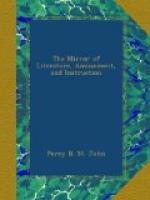in a modern painting of ’Christ riding into
Jerusalem;’ it was amongst a group of Jews, and
next to a likeness of Voltaire. I believe
the painter intended to contrast the countenances
of the Christian and infidel poets, and thus pay a
handsome compliment to the former; but the taste that
placed the ancients and moderns together, remind me
of a fine old painting of the Flemish school; a ‘David
with Goliah’s head,’ in the fore-ground
of which were a number of fat Dutchmen, dressed
in blue coats and leather breeches, with pipes
in their mouths.”—“Raphael,”
says a little French work on painting, in my possession,
speaking of unity of time, “A peche
contre cette regle, dans son tableau d’Heliodore,
ou il fait intervenir le Pape Jules 2 dans le Temple
de Jerusalem porte sur les epaules, des Gonfalonniers.”
The same work notices a breach of the unity of
design in Paul Veronese, “qui dans la
partie droite d’un de ses tableaux, a represente
Jesus Christ benissant l’eau, dont il va etre
baptise par St. Jean Baptiste; et dans la partie gauche
notre Seigneur tente par le diable.”—Upon
the celebrated “Transfiguration” of Raphael,
I heard an artist remark, “undoubtedly it is
the first picture in the world, yet the painter has
erred in these respects:—the upper portion
of the picture is occupied by the subject, but the
lower and fore-ground by the Healing of the Demoniac.
Now that event did not happen until after the transfiguration,
and we infringe upon our Saviour’s ubiquity
by supposing it to occur (contrary to the sacred story)
at the same time. He may, indeed, as God
be omnipresent, but as man, the New
Testament no where asserts that the Incarnate Presence
was in different places at the same moment.”
Instances of erroneous judgment are frequent in those
who illustrate holy writ. Some have attempted
to embody Him, “whom no man hath seen
at any time.” Some have filled their skies
with beings as little aerial as possible, or apotheoses
of the Virgin and sundry saints. Angels, as some
represent them, even in whole lengths, are by anatomists
regarded as monsters; but what then are the
chubby winged heads without bodies, with which
some artists etherealize their works. Some err
by mingling on the same canvass the sacred and profane;
scripture characters and the non-descripts of heathen
mythology. Nor is poetry free from the latter
error, as is exemplified in the major and minor epics,
&c., of many Christian poets. The drawings of
the monks, splendid in colouring and beautiful in
finish, are mostly ludicrous in design, from glaring
anachronisms, erroneous perspective, &c. I saw
a print in Montfaucon, where fish were gamboling like
porpusses on the surface of the sea, and one or two
were visible through the paddles of a boat.
In the same volume was a print of the apotheosis of
St. Louis, from an illumination. The holy prince
was represented dying in the fore-ground, but over
head were a couple of angels flying away with his
soul, (under the figure of a wretched infant, skinny
and naked, save the glory that covered his head,)
in a kind of sheet, or rather sack.




